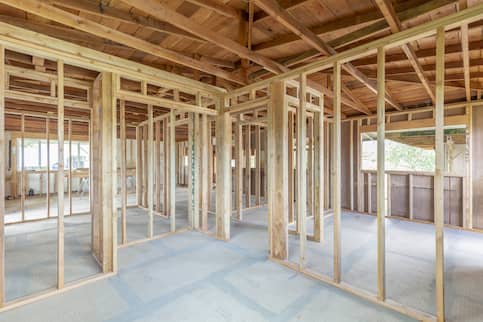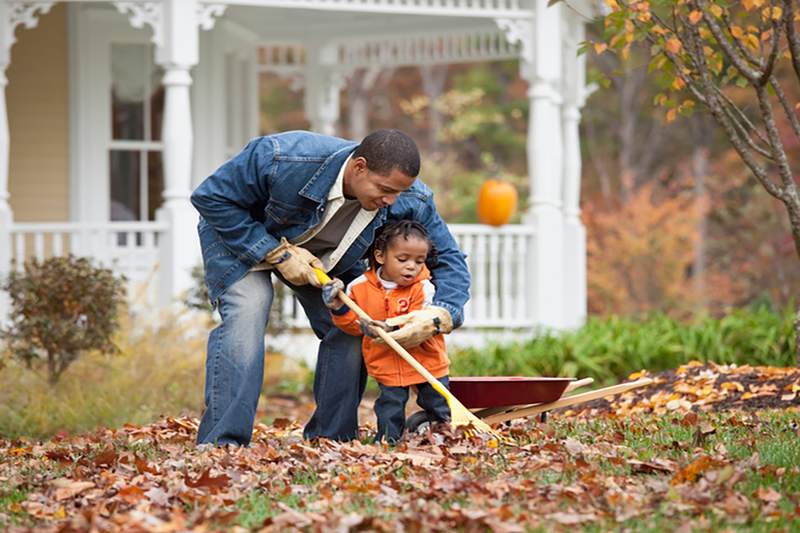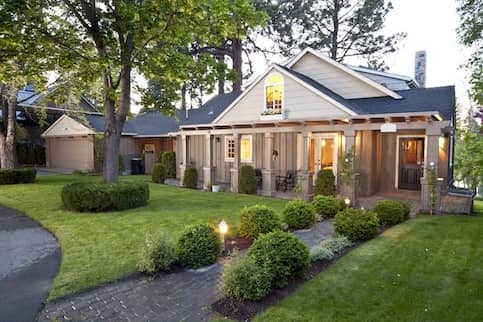Rising home prices in recent years have left many would-be buyers priced out of the market. Some aspiring homeowners may pivot to the idea of building a home, only to find the cost of materials and labor to be higher than expected. If you’re looking to cut your home-building costs, here are 14 ways to save money.
Key Takeaways:
- Take time to understand the costs, what’s involved in building a home, how much you can do yourself, and when you need help.
- Simplifying the design of your home can save you money. You also might consider a different type of home than the traditional single-family house.
- Looking for discounted materials can save money in the short term, while energy-efficient upgrades save money over the long term.
1. Take Time To Plan And Budget Everything
Building a home can come with costs you probably won’t consider when setting your budget for buying a home. To figure out a reasonable construction budget, you’ll need to learn more about the process and the specific costs associated with it.
- Land: You’ll need a plot to build on. Before you decide on a lot or apply for a land loan, you’ll want to consider whether it’s construction-ready or needs to be reshaped or leveled. How about erosion control? You’ll want to know the answers before deciding where to buy.
- Architects: Even if you have a precise idea of how you want your home built, consider hiring an architect. They have experience drawing up floor plans that will make the process much easier. They also can advise you on any unique features you have in mind.
- Contractors: Even though working with a contractor costs more, an experienced contractor can help you avoid expensive mistakes. Similar to working with an architect, having this professional on your team can provide you with advice and help flesh out the logistics. Contractors also will be familiar with the safety and legal requirements for construction in your area.
- Building materials. Experienced contractors can suggest and source the best and most durable materials to work with. Some may get you deals on materials through their relationships with suppliers.
- Permits: Before you begin construction, you need building permits. Building a home without permits is risky – the local government could charge you hefty fines or order you to take down the project. Worse, you could face an expensive lawsuit if an accident occurs at the construction site.
Once you grasp the costs associated with home building, start putting together a budget that realistically reflects the cost of land, labor and materials in your area.
If you’re worrying about these costs stacking up, look into a construction loan. Construction loans are available for a wide range of projects, so you should quickly find one that meets your needs and gets your build moving.
What’s Your Goal?
Buy A Home
Discover mortgage options that fit your unique financial needs.

Refinance
Refinance your mortgage to have more money for what matters.
Tap Into Equity
Use your home’s equity and unlock cash to achieve your goals.
2. Choose A Site That’s Easy To Build On
It’s important to have a strong foundation when building a home. Make sure your land is suitable to build on and understand what it will cost to excavate or reshape it if needed. You’ll also need to make sure your project meets local zoning codes. Codes in some areas might restrict or prohibit swimming pools, garden sheds or other features.
3. Be Your Own Contractor
If you have construction experience or friends or family in the business, you may be thinking about building your home on your own. If you genuinely have the right resources – skilled laborers, reliable and safe-to-operate tools, and other basics – then building your home yourself can save you a lot of money. The more you choose to do yourself, the more money you can save. You’ll also be responsible for any mistakes or errors which may cost you more in the long run.
4. Know When You Need Professional Help
No matter how much you think you can handle, structural tasks and installing plumbing and electricity are best left to the experts. Consider at least consulting help when dealing with tasks typically done by a licensed professional.
Ready To Become A Homeowner?
Get matched with a lender that can help you find the right mortgage.
5. Use A Simple Layout
A home with a simple design – square or rectangular shapes, for example – is easier and cheaper to build than a more elaborate plan. It’s also generally cheaper to build upward, not outward. Don’t underestimate how much landscaping, decks, paint and decor can spruce up a home’s exterior. If a simple build meets your needs, consider going with the affordable option and reaping the rewards.
6. Consider Other Types Of Homes
If you don’t have to have a single-family house, other home types can save you money. For example:
- Prefab homes. A prefabricated home is manufactured in a factory and delivered to your property for assembly.
- Modular home. This is a type of prefab home that is built in a factory and then attached to a permanent foundation.
- Manufactured home. A manufactured home is built in a factory and conforms to building codes set by the U.S. Department of Housing and Urban Development.
- Kit homes. This type of prefab home is delivered to you by the manufacturer in parts, like a model kit. A kit house can cost as little as $30 per square foot.
- Barndominiums. This converts a barn-like structure to include multiple condominium-style homes. According to Element Homes, these typically cost between $65 and $160 per square foot.
- A-frame home. This type of home has a triangular shape that requires less roofing material. These homes often cost between $100 to $300 per square foot.
7. Keep Water Usage Areas Together
By designing your home so the kitchen, laundry room and bathrooms are near each other, either vertically or horizontally, you can save money on plumbing materials. According to the National Association of Home Builders, installing an efficient plumbing system can save you up to 25%. It also can reduce your risk of leaks and water damage.
Take The First Step To Buying A Home
Find a lender that will work with your unique financial situation.
8. Choose A Basic Roof Design
A simpler roof can save you money. Although a multilevel roof may look cool, it’s almost always cheaper to go with a plain, gently sloping roof. Not only will it save you money, but its structure poses less risk of leaks or water damage. Simple roofs also tend to be easier to clean, maintain and repair. If you’re on a tight budget or simply don’t care what your roof looks like, then choosing a simple design can save you money.
9. Install Energy-Efficient Features
Building an energy-efficient home is good for the planet and saves you money. According to Element Homes, green buildings usually cost between 1% and 12% more to build, but the average energy savings in the first year alone is 10.5%. An energy-efficient home also can reduce water consumption by 20% to 30% and carbon dioxide emissions by up to 35%.
The drawback for many people is the initial cost of these features, which can be relatively high. Installing solar panels typically costs about $30,000 but is offset considerably by federal tax credits, according to EnergySage, a clean energy marketplace. EnergySage estimates that homeowners can save from $28,000 to $120,000 over 25 years by installing solar panels.
Viewing energy-efficient upgrades as a long-term investment instead of a one-time purchase can make the price tag much less intimidating.
10. Build Off The Grid
Off-the-grid homes rely on natural energy resources, like solar or wind-powered generators and composting toilets. Many self-sufficient homeowners also take part in gardening and harvesting homegrown foods. If you’re passionate about sustainability and want to try the net-zero lifestyle, check out off-grid home plans or the expansive online community for additional insights and information.
11. Skip The Expensive Finishes, For Now
If your budget is tight or unexpected costs come up, don’t panic. While expensive design options are nice, they are choices that can be made later on. If all you can afford right now is carpet instead of hardwood, remember that’s a feature you can upgrade later when you can afford it. Construction is a time to focus on building a strong foundation with essential amenities – finishing touches can always come later.
12. Build A Tiny House
Tiny homes are in style, but their real appeal is that they’re affordable. Since tiny homes are, well, tiny, they cost a lot less to build than conventional homes. Tiny homes typically cost anywhere from $30,000 to $60,000, depending on how luxurious you want your build to be. They also cost a lot less to maintain than a standard home. You can build your tiny home on wheels if you want to travel or plan to move.
However, tiny homes aren’t for everyone. The most significant drawback to tiny homes, besides their limited size, is financing them is difficult. Tiny homes typically aren’t eligible for loans. If you’re looking for something new and are confident you can pay off your tiny home upfront or are willing to rely on another form of credit to pay for it, it may be an option worth exploring.
13. Use Unconventional Building Materials
Another option for saving money is building a home with unusual materials. One example is the popularity of turning metal shipping containers into homes. Not only is recycling materials sustainable, but it can save you money on your build.
Some common but cheap materials you can use to build a home include:
- Reclaimed wood
- Prefabricated panels
- Precast concrete
- Brick
- Bamboo
- Cob
14. Look For Discounted Building Materials
On a similar note, you can save money by looking for discounted or discontinued building materials. Some suppliers offer a builder’s discount if you’re building an entire house. Others have discounts on items that may be overstocked or discontinued. Some contractors also have access to discounts through their network.
FAQ
Here are answers to common questions about the cheapest ways to build a house.
The Bottom Line
Whether you’re looking to build a unique and more unconventional home, are interested in living sustainably, or just want to save as much as you can with your home build, there are plenty of options for building your new home. Working with experienced professionals can help you create a floor plan for a type of home that can maximize your savings.

Rory Arnold
Rory Arnold is a Los Angeles-based writer who has contributed to a variety of publications, including Quicken Loans, LowerMyBills, Ranker, Earth.com and JerseyDigs. He has also been quoted in The Atlantic. Rory received his Bachelor of Science in Media, Culture and Communication from New York University. He also completed the SoFi/Coursera Fundamentals of Personal Finance Specialization consisting of five courses: Introduction to Personal Finance, Saving Money for the Future, Managing Debt, Fundamentals of Investing, and Risk Management in Personal Finance.












